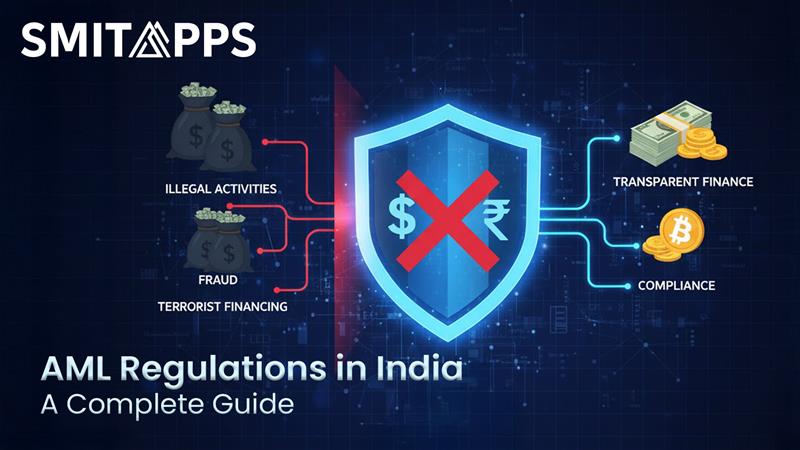For the growing Fintech companies in India, following the rules to stop illegal money (Anti-Money Laundering, or AML) isn’t just a suggestion—it’s absolutely necessary to stay in business.
What is AML and Why Does It Matter for Fintech?
AML stands for Anti-Money Laundering. It’s a set of laws and steps to stop people from turning “dirty” money (from crimes like drug dealing or fraud) into “clean” money that looks legal. For fintech companies—like those handling payments, loans, or crypto—this is huge. You deal with digital money moves, which can be fast and hard to track. Breaking AML rules can lead to big fines, lost trust, or even shutdowns. In India, strong AML helps keep the economy safe and meets global standards.
India’s AML system started getting serious in the early 2000s to fight rising frauds. Today, it’s updated often to handle new tech like apps and virtual assets.
A Quick History of AML in India
India’s main AML law is the Prevention of Money Laundering Act (PMLA) from 2002. It lets the government investigate, seize dirty money, and punish offenders with jail time (3-7 years, or up to 10 for drug crimes) and fines. Over the years, changes have made it stronger:
- 2005: Rules for keeping records and reporting odd transactions.
- 2009: Better sharing info with other countries.
- 2012: Added checks for politically important people (PEPs) and non-profits.
- 2015: Defined who must report and follow rules.
- 2023: Big updates for crypto and virtual assets, plus stricter checks for owners and pros like accountants.
In 2025, things are building on these. For example, new agreements between agencies help share info faster to catch issues early.
Who Runs AML in India?
Several groups watch over AML to keep things tight:
- Financial Intelligence Unit-India (FIU-IND): The main hub. They collect reports on weird transactions, analyze them, and share with police or other countries. Fintech must register here if dealing with virtual assets.
- Reserve Bank of India (RBI): Sets rules for banks, NBFCs (non-bank lenders), and payment apps. Their KYC (Know Your Customer) guide is key for checking users.
- Securities and Exchange Board of India (SEBI): Handles stock markets and investments, making sure brokers and funds follow AML.
- Insurance Regulatory and Development Authority of India (IRDAI): For insurance firms, focusing on stopping laundering through policies.
- Enforcement Directorate (ED): Investigates and seizes assets tied to crimes.
These teams work together. In 2025, FIU-IND signed deals with RBI (April) and the National Housing Bank (January) for better info sharing. This helps fintech spot risks quicker.
The Core Laws and Rules
The PMLA is the big one, but it comes with rules and guides:
- PMLA 2002: Defines money laundering as hiding crime money. It covers banks, fintech, real estate, lawyers, and more.
- PML Rules 2005 (Updated 2023): Say you must keep transaction records for 5 years, check customer details, and report suspicious stuff.
- RBI’s KYC Master Direction 2016 (Updated 2025): This is your go-to for user checks. Latest changes in August 2025 add stronger due diligence, Aadhaar face checks, and help for people with disabilities. It also covers occasional big transfers (over ₹50,000) and international wires.
- Other Laws: Things like the Unlawful Activities Prevention Act (for terror funding) and Foreign Exchange Management Act tie in.
For fintech, if you’re into crypto, you’re a “reporting entity” since 2023. You must follow full AML like banks.
What Fintech Companies Must Do
As a fintech, you’re a “regulated entity” or “reporting entity.”
Here’s what you need:
- Know Your Customer (KYC): Check who your users are. Use IDs like Aadhaar, PAN, passport. Do video KYC for digital sign-ups. Rate users as low, medium, or high risk based on their background, location, and activity.
- Customer Due Diligence (CDD): Dig deeper for high-risk users. Find out who really owns the account (beneficial owners—people with 10-25% control). Update checks every 2-10 years by risk level.
- Transaction Monitoring: Watch for odd patterns, like big sudden transfers or links to risky countries. Use AI tools to spot issues.
- Reporting:
- Cash Transaction Reports (CTR): Tell FIU-IND about cash deals over ₹10 lakh.
- Suspicious Transaction Reports (STR): Report anything fishy within 7 days—no delays!
- Keep records for 5 years.
- Risk Assessment: Do your own checks on ML/TF risks yearly. Train staff and have a top officer handle AML.
- For Crypto and VDAs: Register with FIU-IND, do full KYC, monitor trades, and report. Tax is 30% on gains, 1% at source.
Breaking rules? Fines up to ₹5 lakh or more, plus jail or asset grabs. In 2024, FIU fined Binance ₹18.82 crore and Paytm ₹5.49 crore for slips—lessons for 2025.
Latest Updates for 2025
India’s AML is evolving fast:
- RBI KYC Changes: In June and August 2025, RBI boosted inclusivity with easier checks for low-risk users and face auth on Aadhaar. Deadlines for old merchants to comply by December 31, 2025.
- Lower Ownership Thresholds: SEBI dropped it to 10% for spotting real owners.
- FATF Praise: India’s 2024 review was good, but watch for high-risk areas like crypto.
- Data Privacy Tie-In: New Digital Personal Data Protection Act rules (drafts open till Feb 2025) link to AML for safe data handling.
Fintech must also follow UN sanctions and freeze assets tied to terror or weapons.
Best Practices for Your Fintech
To stay safe:
- Use auto-tools for KYC and monitoring—think AI for alerts.
- Train your team often on new rules.
- Do internal audits and fix gaps fast.
- Partner with compliant vendors only.
- Balance user ease with strong checks, like quick video KYC.
This cuts risks and builds trust.
Challenges and What’s Next
Fintech faces hurdles like fast tech changes (e.g., decentralized finance) and cross-border deals. But India aims to innovate while staying secure. Look for more AI in regs and global team-ups.
Wrapping Up
AML in India isn’t just boxes to tick—it’s about protecting your business and users. Follow PMLA, RBI guides, and report on time to avoid trouble. If you’re a fintech, talk with experts or use tools for easy compliance. Stay updated, as rules change quick!

